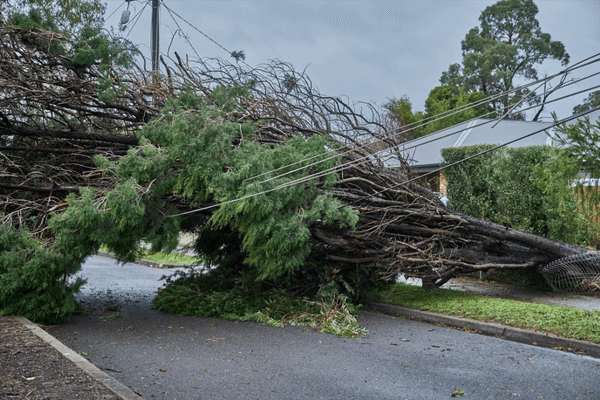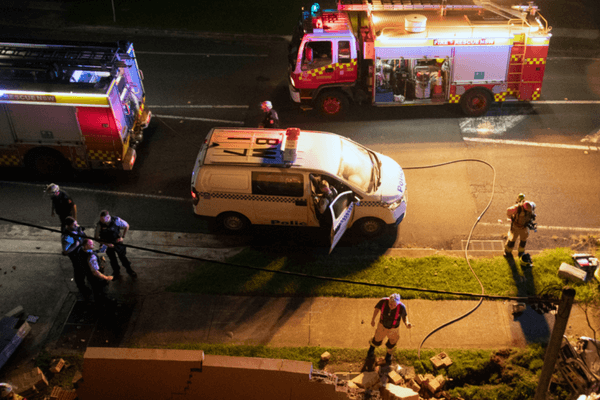Storms aren’t going away
Chances are, you have been called upon more frequently to assist with storm-related events of late. The cost of natural hazard events in Australia has more than doubled since the 1970s and totalled $35 billion over the past decade. The storms and floods that impacted South-East Queensland and coastal New South Wales in February and March 2022 resulted in 197,000 claims, estimated to cost $3.35 billion in insured losses. In 2021, one of Australia's largest insurers NRMA, recorded 35,000 storm and hail claims on Australia’s East Coast for homes. Storm and hail claims account for almost 60% of all NRMA home claims.
5 steps to a safe response
- Contact your communications centreYour contact centre can engage the local electricity distributor to isolate the power.
- Set up an exclusion zoneEstablish exclusion zones where possible to keep bystanders and emergency personnel at least 8 metres away from live wires or anything they’re touching.
- Be alertStay vigilant and look out for any potential electrical hazards at the location such as damaged solar panels.
- Leave it to the expertsNever touch any powerlines, electrical equipment or solar panels
- Wait for the 'All Clear'Do not proceed until the electricity distributor on site has confirmed that the area is safe to enter.
Danger ahead
It’s important to remember when you’ve been called in to help, it means something has gone wrong which may include damage to the electricity network. Storms and wild weather can bring down trees or result in flying debris taking down powerlines and electrical equipment.
Understanding the electrical risks you may face, and actively looking for electrical dangers when you arrive at an emergency site will help keep you safe when responding to emergencies.
Damaged and fallen powerlines
Fallen powerlines or wires are common following a storm or strong winds. Never assume the power is off, even if the homes in the area are blacked out.
Always assume wires are live, notify your communications centre so they can engage the local electricity distributor. The electricity distributor in your area will be immediately dispatched to turn off the power.
Remain at least 8 metres away, or even further if wires are jumping or sparking.
Electrical equipment hidden in vegetation and storm debris
In the aftermath of a storm, there are often fallen trees, vegetation and other storm debris scattered throughout the streets and across people’s homes. Storm debris can often hide electrical hazards. Take extra care when working through the clean up efforts.
If you find fallen wires or any electrical equipment, always assume they’re live and treat with extreme caution. Stop and stand back and call out the risk to everyone in the area.
Physical contact with, or even close proximity to live equipment has the potential to cause an electric shock which may result in serious injury or death.
Watch your step with water
Water is a conductor of electricity, and while it might seem unavoidable in a storm response, it’s important to remember the dangers it presents when around electricity.
The general rule of thumb is to stay 8 metres away from fallen wires and anything they’re touching. However, if there’s water about, it’s best to keep extra distance as fallen wires can energise puddles and the ground.
Always ensure you’re wearing appropriate footwear (rubber soled) when responding for your own safety.
Damaged solar panels
With 1 in 4 Australian homes having solar panels on their roofs it’s a hazard that’s more common than you might think.
Responders need to be careful as solar panels will continue to produce electricity even when they’re damaged, as long as they are exposed to light, regardless of whether the electricity supply has been switched off. Artificial light such as that from response vehicles can also generate small amounts of electricity.
Being positioned on roofs, solar panels are particularly susceptible to damage from hail, fallen trees or storm debris.
It's critical that any repairs to damaged solar panels are always left to the professionals. Master Electricians Australia provides a free hotline you can refer to homeowners to connect with a local electrician (1300 889 198).
Low hanging powerlines
It’s not only on site where you could be exposed to electrical hazards when responding to a storm. Responders should be switched on and look out for hazards while making their way to the site.
Response vehicles should be on the look out for low hanging or fallen powerlines as they’re driving to a site, as they face the risk of being caught in sagging powerlines following a storm event.
Learn what to do if your vehicle comes in contact with fallen wires.

Trees on powerlines

